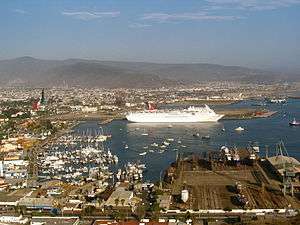Municipalities of Mexico
Municipalities (municipios in Spanish) are the second-level administrative divisions of Mexico, where the first-level administrative division is the state (Spanish: estado). As of the establishment of two new municipalities in Chiapas in September 2017,[1] there are 2,448 municipalities in Mexico, not including the 16 delegaciones of Mexico City.[2] The internal political organization and their responsibilities are outlined in the 115th article of the 1917 Constitution[3] and detailed in the constitutions of the states to which they belong.
Structure
All Mexican states are divided into municipalities. Each municipality is autonomous; citizens elect a "municipal president" (presidente municipal) who heads an ayuntamiento or municipal council, responsible for providing all the public services for their constituents. This concept, which originated after the Mexican Revolution, is known as a municipio libre ("free municipality"). A municipal president heads the ayuntamiento (municipal council). The municipal president is elected by plurality and cannot be reelected for the next immediate term. The municipal council consists of a cabildo (chairman) with a síndico and several regidores (trustees).
If the municipality covers a large area and contains more than one city or town (collectively called localidades), one city or town is selected as a cabecera municipal (head city, seat of the municipal government) while the rest elect representatives to a presidencia auxiliar or junta auxiliar (auxiliary presidency or council). In that sense, a municipality in Mexico is roughly equivalent to the counties of the United States, whereas the auxiliary presidency is equivalent to a township. Nonetheless, auxiliary presidencies are not considered a third-level administrative division since they depend fiscally on the municipalities in which they are located.
North-western and south-eastern states are divided into small numbers of large municipalities (e.g. Baja California is divided into only five municipalities), and therefore they cover large areas incorporating several separated cities or towns that do not necessarily conform to one single conurbation. Central and southern states, on the other hand, are divided into a large number of small municipalities (e.g. Oaxaca is divided into 570 municipalities), and therefore large urban areas usually extend over several municipalities which form one single conurbation. Although an urban area might cover an entire municipality, auxiliary councils might still be used for administrative purposes.
Municipalities are responsible for public services (such as water and sewerage), street lighting, public safety, traffic, supervision of slaughterhouses and the cleaning and maintenance of public parks, gardens and cemeteries. They may also assist the state and federal governments in education, emergency fire and medical services, environmental protection and maintenance of monuments and historical landmarks. Since 1983, they can collect property taxes and user fees, although more funds are obtained from the state and federal governments than from their own collection efforts.
History

Since the Conquest and colonization of Mexico, the municipality became the basic entity of the administrative organization of New Spain and the Spanish Empire. Settlements located in strategic locations received the status of city (the highest status within the Empire, superior to that of villas and pueblos) and were entitled to form an ayuntamiento or municipality. After Independence, the 1824 Constitution did not specify any regulation for the municipalities, whose structure and responsibilities were to be outlined in the constitution of each state of the federation. As such, every state set its own requirements for a settlement to become a municipality (usually based on population). The Constitution of 1917 abolished the jefatura política ("political authority"), the intermediate administrative authority between the states and converted all existing municipalities into municipios libres ("free municipalities"), that is, gave them full autonomy to manage local affairs, while at the same time restricting the scope of their competencies.[4] However, in 1983 the 115th article was modified to expand the municipalities' authority to raise revenue (through property taxes and other local services) and to formulate budgets.
Ranking of municipalities
By population
Data from the 2015 Intercensal Survey by INEGI.[5]
| Ranking | Municipality | State | Population |
|---|---|---|---|
| 1 | Ecatepec | Mexico | 1,677,678 |
| 2 | Tijuana | Baja California | 1,641,570 |
| 3 | León | Guanajuato | 1,578,626 |
| 4 | Puebla | Puebla | 1,576,259 |
| 5 | Guadalajara | Jalisco | 1,460,148 |
| 6 | Juárez | Chihuahua | 1,391,180 |
| 7 | Zapopan | Jalisco | 1,332,272 |
By area
Data from Los Municipios con Mayor y Menor Extensión Territorial by the Instituto Nacional Para el Federalismo y el Desarrollo Municipal[6]

| Ranking | State | Municipality | Area (km²) |
|---|---|---|---|
| 1 | Baja California | Ensenada | 51,952.26 |
| 2 | Baja California Sur | Mulegé | 33,092.20 |
| 3 | Coahuila | Ocampo | 26,433.60 |
| 4 | Baja California Sur | La Paz | 20,275.00 |
| 5 | Quintana Roo | Othón P. Blanco | 17,189.75 |
| 6 | Chihuahua | Ahumada | 17,131.48 |
| 7 | Baja California Sur | Comondú | 16,858.30 |
| 8 | Chihuahua | Camargo | 16,066.01 |
| 2,438 | Tlaxcala | San Lorenzo Axocomanitla | 4.34 |
Municipalities of Mexico City
Mexico City is a special case in that it is not organized as a municipality, but as a federal district as the capital of the federation. It is administered through the Government of the Federal District and it has its own unicameral Legislative Assembly. For administrative purposes, the Federal District is subdivided into delegaciones, or boroughs. They are not identical to municipalities, but since 2000, they enjoy a certain degree of political autonomy since residents within a borough directly elect a local borough head of government (called jefe delegacional). However, boroughs do not form local [municipal] councils, are not constituted by a group of trustees, and do not have regulatory powers, most of which are exercised by the Federal District's government. Most public services are organized by the Federal District even if some responsibilities are carried out by the boroughs. Still, at the federal level, the boroughs are considered a second-level territorial division for statistical data collection and cross-municipal comparisons.
Other municipalities in Mexico have chosen to use a similar administrative internal organization. All municipalities of Baja California are subdivided into boroughs, or delegaciones. The municipality of Mexicali for example, is divided into 14 boroughs besides the City of Mexicali, which comprises the municipal seat and three additional metropolitan boroughs.
The Municipality of Santiago de Querétaro is subdivided into seven boroughs. Nonetheless, the heads of government of the boroughs are not elected by the residents but rather appointed by the municipal president. Unlike the boroughs of Mexico City, which are second-level administrative divisions, the boroughs of the municipalities are third-level administrative divisions.
See also
References
- ↑ "Constitución Política del Estado Libre y Soberano de Chiapas". Article 2, Act of September 6, 2017 (PDF) (in Spanish). Retrieved January 5, 2018.
- ↑ At the time of the 2015 Intercensal Survey, there were 2,441 municipalities in Mexico according to INEGI, excluding the delegaciones of Mexico City: "División territorial de México" (in Spanish). INEGI. Retrieved January 5, 2018. Since then, six municipalities have been created in Chiapas (Belisario Domínguez, Emiliano Zapata, El Parral, Mezcalapa, Capitán Luis Ángel Vidal, Rincón Chamula San Pedro) and one in Quintana Roo (Puerto Morelos), bringing the total to 2,448.
- ↑ "Constitución Política de los Estados Unidos Mexicanos". Article 115, of 1917 (in Spanish). Retrieved January 5, 2018.
- ↑ Inform sobre Desarrollo Humano México 2004 Archived 2007-01-26 at the Wayback Machine. p. 50
- ↑ "Encuesta Intercensal 2015: Presentación de resultados" (PDF). INEGI. p. 15. Retrieved 2016-11-08.
- ↑ Los Municipios con Mayor y Menor Extensión Territorial Archived 2011-05-17 at the Wayback Machine. Instituto Nacional Para el Federalismo y el Desarrollo Municipal
External links
- Mexican government structure
- History (in Spanish) of the Mexican constitution
- Mexico Portal de Información Municipal (in Spanish)